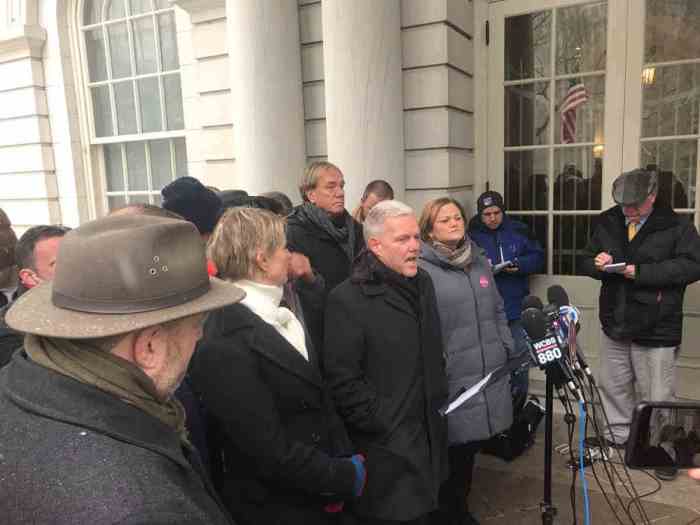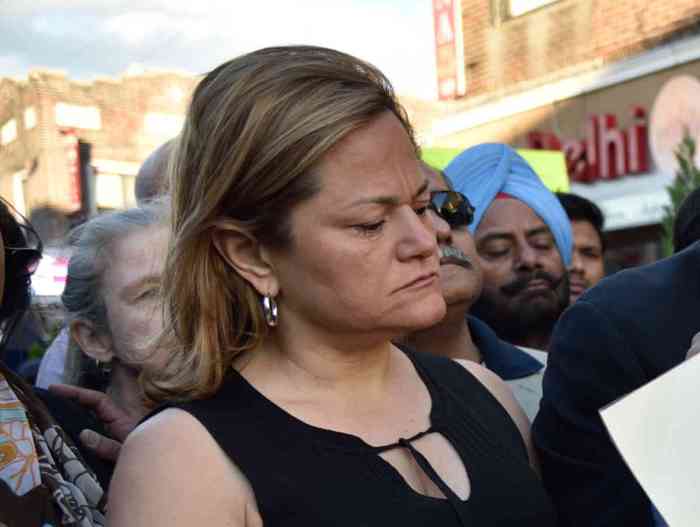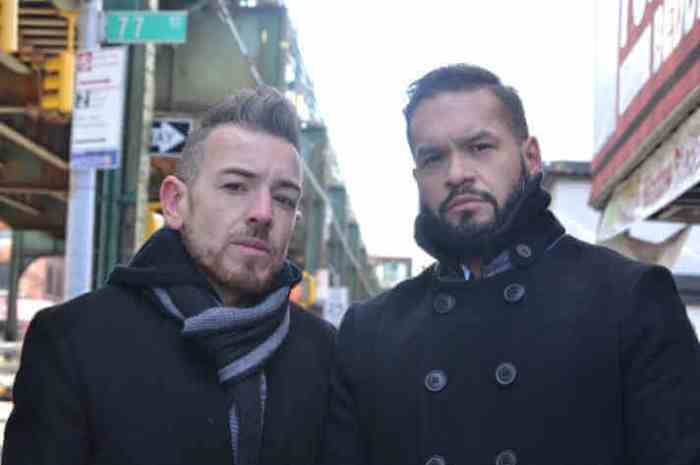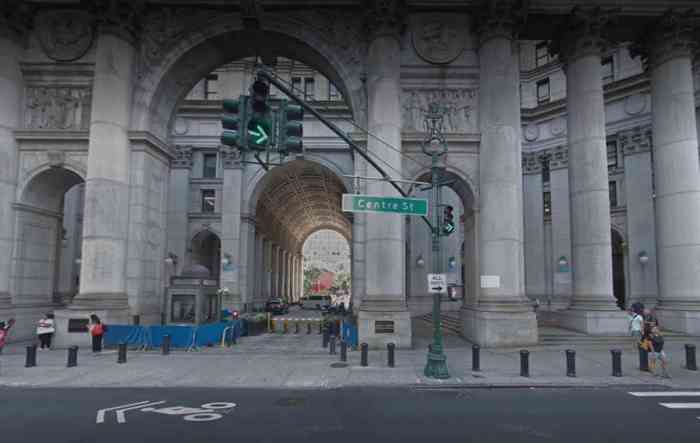A rendering of the New York City AIDS Memorial set to be dedicated on December 1. | NYCAIDSMEMORIAL.ORG
A solemn ceremony bringing together leading AIDS organizations and advocates as well as public officials will mark World AIDS Day 2016, with the dedication of the New York City AIDS Memorial at the St. Vincent’s Triangle Park.
The Memorial, a 1,600-square-foot corner of the park, commemorates the shattering struggle against the epidemic that wreaked widespread death among gay and bisexual men and many other New Yorkers beginning in the early 1980s.
The dedication marks the culmination of a five-year drive to finally create a public space to honor those lost to HIV as well as the many activists who battled to bring public attention and government dollars to bear on the unprecedented health crisis.
Five years of work yields striking permanent recognition of epidemic that changed everything
The December 1 event is co-sponsored, in part, by the New York City Department of Health and Mental Hygiene and the New York State Department of Health, and both Mayor Bill de Blasio and Governor Andrew Cuomo have been invited to participate.
The poet Kamilah Aisha Moon will read from Walt Whitman’s Civil War poems on World AIDS Day. | KAMILAHAISHAMOON.ORG
Drawing on the poetry of Walt Whitman, the dedication will juxtapose the more than 100,000 New Yorkers who died from HIV disease to the 54,000 local soldiers who died in the Civil War. Poet Kamilah Aisha Moon will read from Whitman’s Civil War poems as part of the ceremony that begins at 11 a.m.
Chris Tepper, a planning professional who was one of the two co-founders of the AIDS Memorial project, called it a “beautiful new city landmark, a new Washington Square Arch that people will recognize” as they enter Greenwich Village.
The Memorial’s 18-foot-high steel canopy that plays with triangular shapes is visible from Greenwich Avenue, Seventh Avenue, and West 12th Street, which define the borders of the three-sided park.
For curious and contemplative visitors who enter the Memorial, Whitman’s words spiral out in ever-grander circles from a central water feature. In total, the park draws on roughly 10,000 words from Whitman’s “Song of Myself,” the poem at the heart of “Leaves of Grass” that the poet revised again and again for decades. The words chosen are carved into the gray granite ground in a design by New York artist Jenny Holzer.
A nurse during the Civil War, Whitman witnessed its carnage up close and his post-war writings reflect sorrow and compassion for the wounded and dead, with the Memorial including his words, “Agonies are one of my changes of garments, I do not ask the wounded person how he feels, I myself become the wounded person.”
Whitman is an iconic figure in the LGBT community, given the unmistakable homoeroticism in his poetry’s celebration of male camaraderie.
The location of the Memorial, Tepper explained, is significant in sitting opposite the former campus of St. Vincent’s Hospital, which housed the city’s first and largest AIDS ward, becoming an epicenter of the local response to HIV. In an early AIDS era of hysteria and scapegoating, activists, doctors, nurses, and volunteers struggled to offer succor to those facing a calamitous illness with few or no effective treatments.
A model of the AIDS Memorial. | DONNA ACETO
The first mentions of AIDS came in a May 1981 story by Lawrence Mass in the New York Native, an LGBT publication, followed quickly by a report from the federal Centers for Disease Control and Prevention and then, on July 3 of that year, a story in the New York Times that concerned what was then a handful of cases. From there, the epidemic grimly escalated. By 1990, already 25,000 New Yorkers had died from AIDS-related illnesses, with many more infected — gay and bisexual men, injecting drug users, and increasingly women, especially in communities of color.
Hysteria, calls for names reporting of HIV-positive people, and even harsh demands for quarantine emerged, and in the early years Gay Men’s Health Crisis and later ACT UP were among the few organized responses to the epidemic.
“We have come a long way since the early days of the epidemic. Even without a cure or vaccine, we have the tools to end AIDS as an epidemic” is the upbeat assessment offered by Charles King, president of Housing Works, one of the leading organizations in the End Aids 2020 Coalition. “Our biggest challenges now are overcoming socioeconomic barriers to care. With expanded access to testing, treatment, and prevention options like PrEP and PEP, we can achieve an end to the epidemic locally, nationally, and globally.”
King was one of the co-chairs of a task force appointed by Cuomo several years ago to chart the state’s push to reduce new infections from roughly 3,000 each year to as low as 750. At that rate of infection, epidemiologists say the scourge will begin to fade of its own accord.
The plan proposed by the task force assumes that by treating those living with HIV so they are no longer infectious and getting negative New Yorkers at risk on pre-exposure prophylaxis, or PrEP, the state can achieve the dramatic reduction in new infections sought. Housing low-income people with HIV is a critical component of the plan, since insecure housing has been shown to deter people from sticking to their drug regimens. Advocates continue to press Albany to provide the funding necessary to support their ambitious goal.
One reason for the optimism advocates have shown has been Obamacare, with King explaining that “in New York, due in no small part to expanded primary care through the Affordable Care Act and better cost efficiencies through Medicaid redesign, we are leading the charge and well on our way” to reaching the 2020 goal. The specifics of how the new Trump regime in Washington moves on its pledge to do away with the ACA will be a critical factor going forward.
In addition to Tepper, the AIDS Memorial was brought to fruition by his fellow urban planner Paul Kelterborn. The two gay men, who never knew a world without HIV, believed strongly that the epic struggle against the disease deserved permanent public recognition. They early on recognized that their project required their persuading Greenwich Villagers to modify plans for the triangular park set to replace an unsightly utility plant that had supported St. Vincent’s Hospital. Merging the two concepts required cooperation and often delicate negotiations. A New York Times story about Tepper and Kelterborn’s efforts prompted Keith Fox, the CEO of Phaidon Publishers, to contact them and, in October 2011, join the project. As chair of the New York City AIDS Memorial Foundation board of directors, Fox spearheaded efforts to mobilize community sentiment in favor of the project and build a network of donors to pay for it.
“We are an all-volunteer organization and the board members do all the work to bring to life a project of this scale,” explained government relations and communications professional Ethan Geto, a board member. With LGBT activism going back to the Gay Activists Alliance in 1971 and professional relationships with LGBT leaders, government officials, and real estate industry interests, Geto was a key mediator between the community and Rudin Management, which donated the space for a park.
“Virtually every LGBT and AIDS organization from all five boroughs made the creation of the AIDS Memorial a top agenda item,” said Geto, who explained that was “a critical factor in getting it accomplished.”
City Comptroller Scott Stringer, when he served as Manhattan borough president, was the first official to pitch in, finding $1 million to help with design and construction of the project. Other funds came from Governor Cuomo, City Council Speaker Melissa Mark-Viverito and her predecessor, Christine Quinn, and Corey Johnson, the out gay city councilmember whose district includes the park.
“Interestingly,” said Geto, “the majority of the funding for the AIDS Memorial came from a small group of city and state elected officials.”
A total of $4 million in public funds were added to the $2 million raised privately.
The New York City AIDS Memorial launched an international design competition in November 2011, chaired by Michael Arad, the designer of the National September 11 Memorial & Museum. Nearly 500 architects from around the world submitted designs, and Studio ai, led by Mateo Paiva and Lily Lim, won the competition to become the park’s architect. It is their design that today is a dramatic new gateway to the West Village.





































